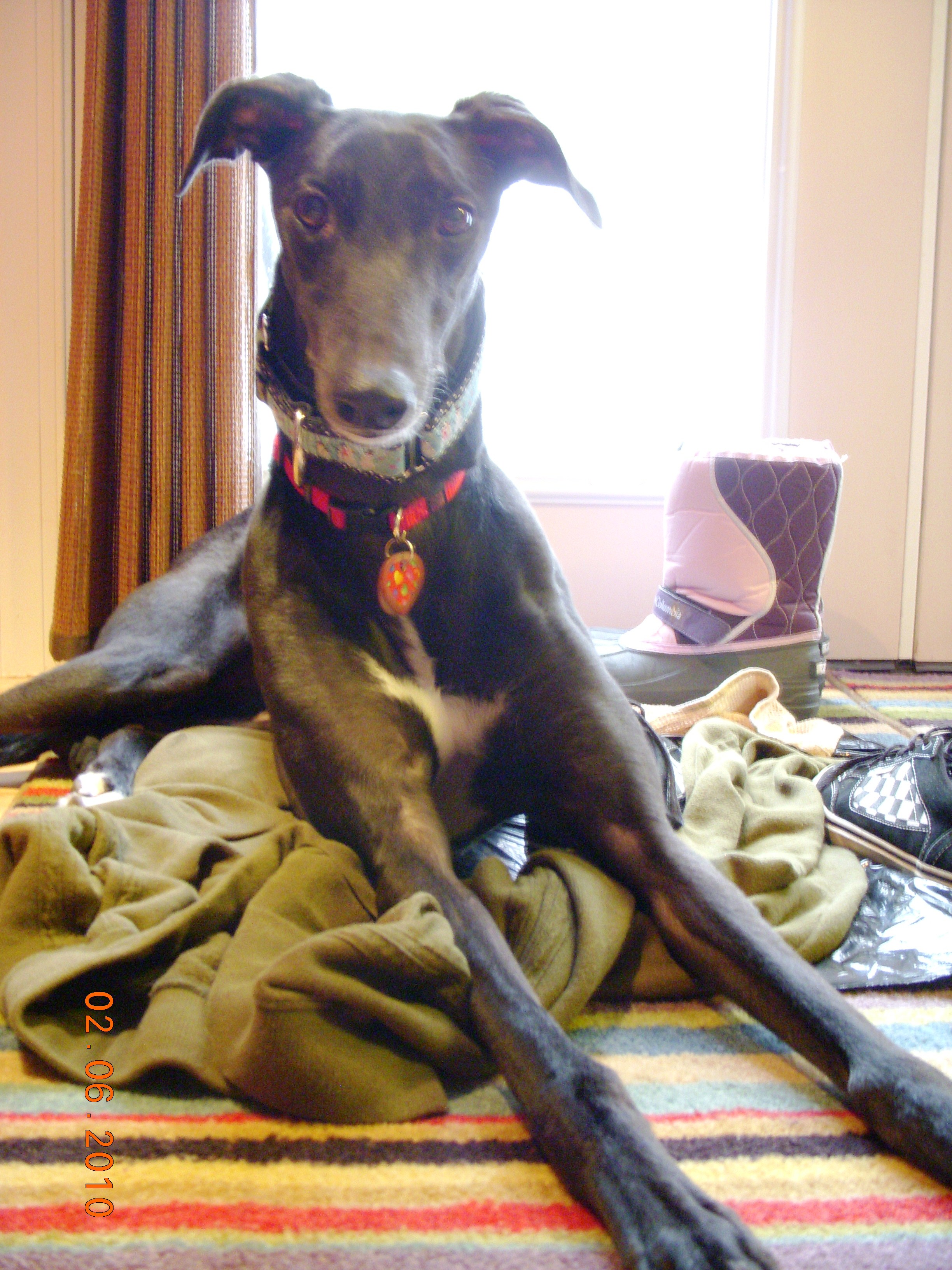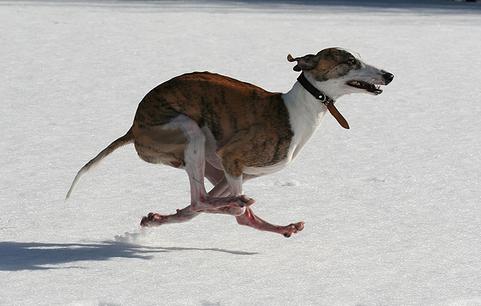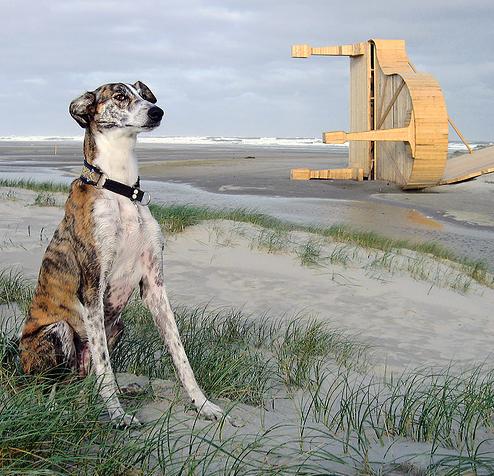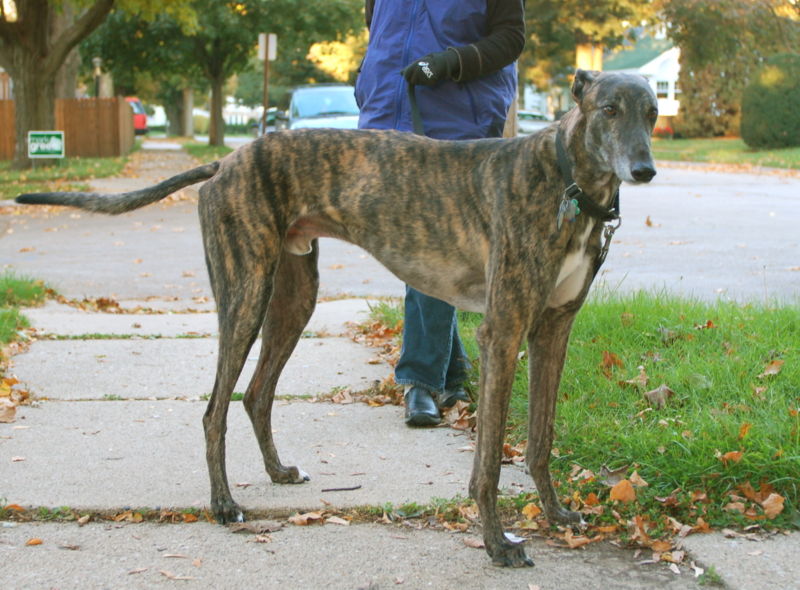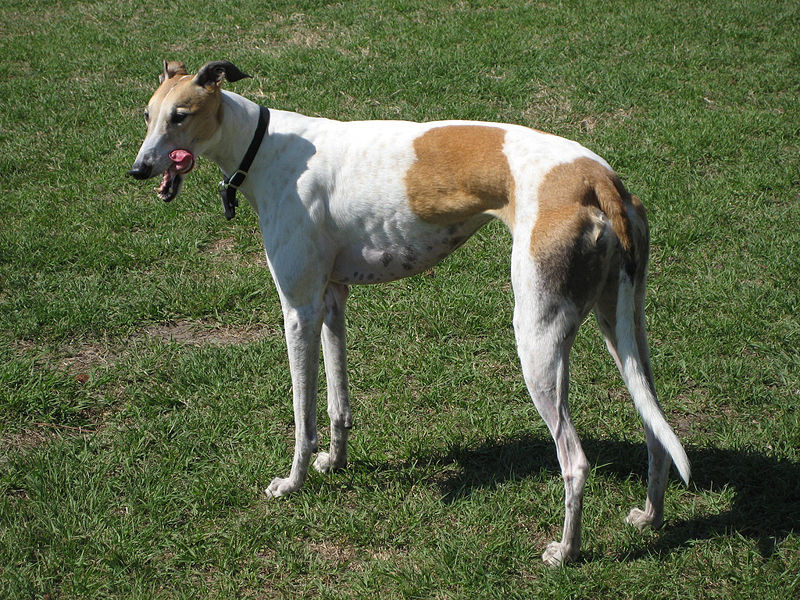
(English Greyhound) The Greyhound is a dog whose physical appearance denotes elegance, speed, and agility. The breed has a long, muscular neck that is slightly arched and slopes gracefully into the shoulders, which are set obliquely. The limbs are perfectly straight, well-set, and turn neither in nor out. They have strong pasterns and a wide, deep chest with comparatively well-sprung ribs. Their back is broad and muscular, and their loins are well-arched and cut up into the flanks. The stifles are well let down and bent, and the hindquarters are long and powerful. Their hocks are rather close to the ground, well bent, and wide. Feet of this breed are hard and close, with good, strong claws. The tail is long, fine and tapered. The head of the Greyhound is long and narrow, and it is widest between the ears. The stop is barely perceptible, and the muzzle is of good length. The breed’s teeth are strong, well-developed, and even in front. Ears of this breed are small and fine, and they are semi-pricked when the dog is excited. They have dark, bright eyes that denote intelligence and spirit. The coat of the Greyhound is short-haired, smooth, and firm in texture.
User added infoGreyhounds placed through GPA are usually 2 to 5 years old, stand between 24 and 31 inches tall at the shoulder and weigh between 50 and 90 pounds. They come in a variety of colors including black, red, blue, fawn, or a combination of these colors. Various shades of brindle and all fore mentioned colors may be broken with white.
add infoThe character of the Greyhound is often undervalued because of the breed’s propensity to be reserved. In fact, the Greyhound is sensitive, sweet, and good-natured. They are elegant, affectionate, and gentle, and they make wonderful pets. This breed should be properly socialized from an early age to prevent the onset of timid behavior. The majority of Greyhounds have a strong prey instinct. They are likely to chase after anything that moves quickly or appears interesting. The breed can be trained to leave cats and other pets alone, and they seldom have any difficulties getting along with other dogs. They are good with children, though they don’t like rough-house play. Older, considerate children are the ideal choice for this breed. Indoors, the Greyhound is so mild, calm, and sociable that it could be construed as lazy. They form strong bonds with their family. This breed doesn’t bark a lot. Show lines of Greyhound are bred more for temperament, but racing lines still make outstanding family pets. They are not difficult to housebreak.
Most racing greyhounds are not housebroken at the racing kennels. They do learn quickly and can be housebroken in about 2 weeks.
add infoSome lines of Greyhound are prone to bloat. It’s ideal that these dogs be fed two or three small meals per day as opposed to one large meal. Greyhounds are also sensitive to drugs, including insecticides. This breed typically lives for 10 to 12 years.
add infoThe Greyhound is an ancient breed that is believed to have descended from the Arabian Sloughi. It’s probable that these dogs were brought to England by traders before the year of 900 AD. Hundreds of years ago, the breed was used to hunt deer and wild boar. The Greyhound is the fastest dog in the world, and it is capable of achieving speeds of over forty miles per hour. Today, the Greyhound is predominately used as a racing dog. After a Greyhound’s racing career is over, it is often destroyed. Greyhound Rescue groups select even-tempered, gentle racers and place them in loving homes. This breed has a number of natural talents including sighting, hunting, racing, watching, agility, and lure coursing.
Not all racing Greyhounds are destroyed. Some owners keep them to breed or just as pets. Some also sell/give them to loving homes.
add infoThe smooth, short-haired coat of the Greyhound is easy to groom and take care of. It should be combed and brushed with a firm bristle brush and dry shampooed only as necessary. This breed is an average shedder.
add infoThe Greyhound is content to live in a small household or apartment if it is sufficiently exercised. They are a comparatively inactive breed indoors, and they are satisfied with just a small-sized yard. They are able to withstand cold weather conditions if they wear a sweater. This breed should be given regular opportunities to run freely on open ground and go for long, brisk walks.
add info| Puppies For Sale | Find a Breeder | Rescue a Dog |
|---|---|---|
| Be the First to take out an Ad! |

Berlin, DE
Die Hobbyzucht im „Butzemannhaus“ ist geprägt von Liebe und Respekt gegenüber den Tieren. Ich sehe meine Tiere nicht... |
Be the First to take out an Ad! |
